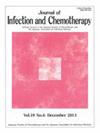Refractory mediastinal pyogenic lymphadenitis in a patient with chronic mucocutaneous candidiasis
IF 1.5
4区 医学
Q3 INFECTIOUS DISEASES
引用次数: 0
Abstract
Chronic mucocutaneous candidiasis disease (CMCD) is an inborn error of immunity characterized by persistent and recurrent mucosal infections caused by Candida spp. STAT1 gain-of-function (GOF) is the main causative gene of CMCD and confers resistance to several pathogens including opportunistic ones, such as Candida spp. This report describes the case of a four-year-old boy with CMCD due to STAT1 GOF variant complicated by refractory mediastinal pyogenic lymphadenitis. The patient received seven weeks of intravenous therapy and subsequently four weeks of oral antibiotics and was cured with no relapse after completion of therapy. During antibiotic therapy, the patient developed exudative pleural effusion and required thoracentesis to improve respiratory distress. Despite the negative culture test results, the patient responded well to antibiotics and was suspected of having a bacterial infection. The immunodeficiency spectrum of CMCD suggested that the infection might have been caused by Staphylococci or Streptococci. In this patient, finding optimal secondary prophylaxis against bacteria was challenging because of allergic reactions to trimethoprim/sulfamethoxazole and subcutaneous immunoglobulin and drug interactions between azole and macrolide antimicrobial agents. Although Janus kinase inhibitors and allogeneic hematopoietic cell transplantation are options, neither treatment is supported by reliable evidence. Further studies are needed to understand the bacterial infections that occur in patients with CMCD and develop better prophylactic management against microorganisms.
慢性皮肤黏液念珠菌病患者难治性纵隔化脓性淋巴结炎1例
慢性粘膜皮肤念珠菌病(CMCD)是一种由念珠菌引起的持续和反复的粘膜感染为特征的先天性免疫错误。STAT1功能获得性基因(GOF)是CMCD的主要致病基因,并使其对包括机会性病原体(如念珠菌)在内的几种病原体具有耐药性。本文报告1例4岁男童因STAT1 GOF变异合并难愈的纵隔化脓性淋巴结炎而患有CMCD。患者接受了7周的静脉注射治疗和4周的口服抗生素治疗,治疗完成后无复发。在抗生素治疗期间,患者出现渗出性胸腔积液,需要胸腔穿刺以改善呼吸窘迫。尽管培养试验结果为阴性,但患者对抗生素反应良好,并怀疑患有细菌感染。CMCD免疫缺陷谱提示感染可能是由葡萄球菌或链球菌引起的。在该患者中,由于对甲氧苄啶/磺胺甲恶唑和皮下免疫球蛋白的过敏反应以及唑和大环内酯类抗菌药物之间的药物相互作用,寻找最佳的二级预防细菌是具有挑战性的。虽然Janus激酶抑制剂和异体造血细胞移植是一种选择,但这两种治疗都没有可靠的证据支持。需要进一步的研究来了解CMCD患者中发生的细菌感染,并制定更好的微生物预防管理。
本文章由计算机程序翻译,如有差异,请以英文原文为准。
求助全文
约1分钟内获得全文
求助全文
来源期刊

Journal of Infection and Chemotherapy
INFECTIOUS DISEASES-PHARMACOLOGY & PHARMACY
CiteScore
4.10
自引率
4.50%
发文量
303
审稿时长
47 days
期刊介绍:
The Journal of Infection and Chemotherapy (JIC) — official journal of the Japanese Society of Chemotherapy and The Japanese Association for Infectious Diseases — welcomes original papers, laboratory or clinical, as well as case reports, notes, committee reports, surveillance and guidelines from all parts of the world on all aspects of chemotherapy, covering the pathogenesis, diagnosis, treatment, and control of infection, including treatment with anticancer drugs. Experimental studies on animal models and pharmacokinetics, and reports on epidemiology and clinical trials are particularly welcome.
 求助内容:
求助内容: 应助结果提醒方式:
应助结果提醒方式:


